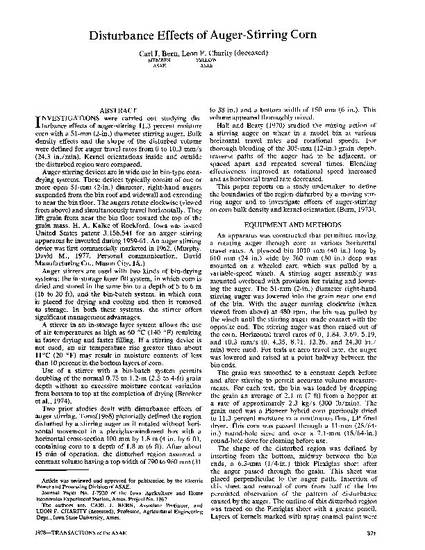
Investigations were carried out studying diSturbance effects of auger-stirring 11.3 percent moisture corn with a 51-mm (2-in.) diameter stirring auger. Bulk density effects and the shape of the disturbed volume were defined for auger travel rates from 0 to 10.3 mm/s (24.3 in./min). Kernel orientations inside and outside the disturbed region were compared. Auger stirring devices are in wide use in bin-type corn-drying systems. These devices typically consist of one or more open 51-mm (2-in.) diameter, right-hand augers suspended from the bin roof and widewall and extending to near the bin floor. The augers rotate clockwise (viewed from above) and simultaneously travel horizontally. They lift grain from near the bin floor toward the top of the grain mass. H. A. Kalke of Rockford, Iowa was issued United States patent 3,156,541 for an auger stirring apparatus he invented during 1959-61. An auger stirring device was first commercially marketed in 1962. (Murphy, David M., 1977. Personal communication. David Manufacturing Co., Mason City, IA.) Auger stirrers are used with two kinds of bin-drying systems: the in-storage layer-fill system, in which corn is dried and stored in the same bin to a depth of 5 to 6 m (16 to 20 ft), and the bin-batch system, in which corn is placed for drying and cooling and then is removed to storage. In both these systems, the stirrer offers significant management advantages. A stirrer in an in-storage layer system allows the use of air temperatures as high as 60 °C (140 °F) resulting in faster drying and faster filling. If a stirring device is not used, an air temperature rise greater than about 11°C (20 °F) may result in moisture contents of less than 10 percent in the bottom layers of corn. Use of a stirrer with a bin-batch system permits doubling of the normal 0.75 to 1.2-m (2.5 to 4-ft) grain depth without an excessive moisture content variation from bottom to top at the completion of drying (Brooker etal.,1974). Two prior studies dealt with disturbance effects of auger stirring. Toms(1968) pictorially defined the region disturbed by a stirring auger as it rotated without hori-zontal movement in a plexiglas-windowed box with a horizontal cross-section 100 mm by 1.8 m (4 in. by 6 ft), containing corn to a depth of 1.8 m (6 ft). After about 15 min of operation, the disturbed region assumed a constant volume having a top width of 790 to 960 mm (31to 38 in.) and a bottom width of 150 mm (6 in.). This volume appeared thoroughly mixed. Hall and Beaty (1970) studied the mixing action of a stirring auger on wheat in a model bin at various horizontal travel rates and rotational speeds. For thorough blending of the 305-mm (12-in.) grain depth, traverse paths of the auger had to be adjacent, or spaced apart and repeated several times. Blending effectiveness improved as rotational speed increased and as horizontal travel rate decreased. This paper reports on a study undertaken to define the boundaries of the region disturbed by a moving stir-ring auger and to investigate effects of auger-stirring on corn bulk density and kernel orientation (Bern, 1973).
Available at: http://works.bepress.com/cjbern/15/

This article is from Transactions of the ASAE 21 (1978): 371–374, doi:10.13031/2013.35306. Posted with permission.